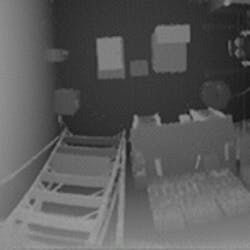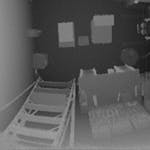Technology Trends: 3-D ranging system measures cargo volume
To date, structured light, triangulation and stereovision scanning techniques have been limited to very specific applications since shape information is not measured directly. Instead, objects of interest are placed in a constrained viewing environments and resulting data are processed to derive shape information. These processes are computationally complex and time consuming, and systems based around them must be tailored to single applications.
RIGHT. Range images consist of 640,000 range points that can be captured in about 1.3 s. By converting range data into shades of gray, images can be displayed on a PC. In such images, lighter shades of gray are closer to the sensor than darker shades of gray. Range information across the top of the boxes is accurate to + 0.25 in., with the sensor 12 ft above the pallet surface.
These limitations are overcome with the Holometrics Air Cargo Automated Measurement System (ACAMS). This 3-D Vision System incorporates PC controlled scanning laser radar technologies with Windows/C++ software to determine the volume of air cargo items located on a pallet.
When the pallet of cargo is placed on an in-floor scale, the image-acquisition cycle begins. In operation, a diode laser beam is scanned across the scene and the distances between the sensor and points in the scene are measured. Resulting surface profile data are transmitted to a Pentium based PC via an RS-422 data link. The image data are accurate to +0.1 inches in all three coordinate axes. The three-dimensional image is then processed, the volume of the cargo is measured, and the dimensional weight is computed. Computed cargo volume and dimensional weight are then displayed, stored, or printed.
"The scanning process yields greater than 500,000 range measurements per second. Most important, ranging accuracy is maintained regardless of the intensity of the reflected laser beam, a first in the industry," says Johnny Berg, president of Holometrics. This same technology is also being applied to robotic operations, road/runway inspection, and materials handling. Due to the universal "goodness" of this imagery, most applications can be accommodated with just changes in software; hardware changes are minimal or not required. "We have also taken great pains to incorporate ruggedness and miniaturization in the system designs," says Berg.

